Contents
Introduction
There are several modules on the market that can be used with Ultimate LRS, including the Hobbyking OrangeRX modules.
However it’s also possible to build yourself an Ultimate LRS Mini. The idea was to propose a simple schematic, and let the community design PCB based on the schematic. The results are above all expectations, and you can find on this page 11 production designs (actually a little more as some design have a different PCB for TX and for RX), 5 other ones in progress.
Notice that IT Luxembourg doesn’t sell any hardware, no PCB, components or modules.
ULRS Mini Reference Schematic
Description
The reference schematic was based on these principles :
- Must be easy to implement, copy, improve
- Small, can fit in the transmitter
- Inexpensive :
- Arduino pro mini 5V = $2.11 (link)
- RFM23BP = $7.66 (link)
- Arduino mini based :
- Integrated voltage regulator, decoupling capacitors, power on LED, reset switch, accessible pins
- Widely supported platform, fifth version of the Arduino mini
- The Arduino mini is one of the smallest Arduino boards, with a size similar to the RFM23BP itself
- Powered at 5V
- Ensure higher power for the RFM23BP module
- Within specs of the atmega328 for 16 MHz operation (avoids eeprom issues)
- Simple wiring
- Arduino mini IO pins facing exactly the RFM23BP pins have been selected, can easily be implemented on a breadboard or prototype board.
- No need for NIRQ pin, only 4 pins + power.
- Maximum safety
- Atmega328 16 MHz powered at 5V (3.3V would be outside specifications)
- All communication pins to RFM23BP, PPM, Serial port, RSSI are resistor protected, which ensures a low current and correct voltage on these pins.
- Filtered RSSI
- No need for an external RSSI lowpass filter
- 7 remaining digital IO pins
Current version
Schematic for version 1.04
Remarks
- In the above schematic please replace R1, R2, R3 and R4 by 1k resistors. This is valid for all ULRS Mini boards.
- The FTDI DTR is connected to the RST pin through a capacitor. This will work, an alternative option would be to connect it directly to the Arduino pro mini ‘DTR’ pin (marked as GRN on the Arduino pro mini boards). However on the Eagle library used above this pin was not available.
- Using linear regulators gives a very clean power supply, but they warm easily if powered from the battery. A drop-in switching regulator replacement for LM7805 could be this one. It could also replace the LM317 but be careful as the pinout is different.
- The schematic is volutarily kept extremely simple and can be made on a breadboard or prototype board. It can be reused as is or modified in your own products.
- Not shown on the schema, but the buzzer can be connected on Arduino digital pin 8.
- Some changes are planned on this schematic :
- When I did this schematic, I thought the atmega could only support 5.5V, and that’s why there’s a 5V and a 6V power supply… which isn’t ideal.So the new design will have only one power supply at 6V (which is supported by both atmega and RFM), and probably a switching power supply as the linear ones warms too much in practice.Powering everything at 6V brings some attention points :
– if I2C devices are connected we must ensure they can support this voltage. Notice that on an I2C port we can’t put resistors on the SDA and SCL pins.
– same for serial ports (but with the resistors there’s no risk)I considered adopting a real voltage shifter for the RFM, but until now nobody complained about a burned RFM in the ULRS Mini boards : the resistors seem to be sufficient and limit the current to an extremely low value. Notice that some implementations such as the Sami board have a full voltage shifter chip, which is perfect, but the reference schematic’s objective is to keep it as simple as possible while staying completely reliable.On the Arduino mini library used, the I2C pins are not accessible, so I’ll try to find another better library that includes all the Arduino mini pins. I know that not many users have implemented I2C devices, except the Adafruit 16 channels extender, but this port will be very useful soon for the diversity features : you’ll be able to use any two ULRS boards and connect them by the I2C port to have a full diversity system. - Edit : recommended voltage is 5V, at 6V the RFM tends to warm too much.
- When I did this schematic, I thought the atmega could only support 5.5V, and that’s why there’s a 5V and a 6V power supply… which isn’t ideal.So the new design will have only one power supply at 6V (which is supported by both atmega and RFM), and probably a switching power supply as the linear ones warms too much in practice.Powering everything at 6V brings some attention points :
ULRS Mini modules
Several users have made ULRS Mini modules based on the reference schematic.
You can choose any of these options, but check out their differences.
Through-holes ULRS Minis
The Monkey Board
A design based on ULRS Mini schematic by rcgroups user neo_04, full infos here and here. Two different boards, one for TX, one for RX.
- TX:
- Fits inside empty Frsky Case
- Pins for FTDI, button, buzzer
- Pins to suit bluetooth module
- Pins to suit teensy telemetry mod
- Switching regulator running everything at 5v.
- With shield on RF module, bluetooth and teensy, everything fits perfectly inside Frsky case with lid on,
just cut a hole to put the antenna through - You choose how to connect the antenna, eg. 5cm pigtail sma lead etc.
- Link to PCB order page for TX : http://dirtypcbs.com/store/designer/…7/ulrs-mini-tx
- RX:
- Distinct PCB for the RX
- Kept simple on purpose
- Pins for power in
- Pins for PPM, TX, RX, GND
- Switching regulator
- RX Physical size ends up at 30mm wide and 47mm long
- Links to PCB order page for RX :http://dirtypcbs.com/store/designer/…rx-cutdown-zip
- Build instructions
The Starfish Board
- Rcgroups user 007trains has made this PCB for you :
- Features :
Small size 3.9cm x 5cm
Onboard TO-220 regulator
Uses through hole components for simple build
Transmitter JR slot compatible connections
Header pin for serial: gnd,rx,tx,5v
Header pin for button and buzzer: gnd,button,buzzer,5v - Link to original post
- Link to PCB order page
The Joey board
- This is another design from the Australian ULRS user yak-54 who made the Wombat board
- A Joey is an infant marsupial, such as a kangaroo (wikipedia), a good name for the small Australian board…
- It fits perfectly into the $5 case sold by Banggood but be careful : it’s not intended to be plugged into an RC TX (it doesn’t have a connector in the right place for this). Have a look at the Starfish or Monkey boards if you want to plug into a RC TX.
The Wombat board
Version 1
Very similar to the Spongeboard, but smaller, this design from Australian rcgroups user yak-54 looks very nice :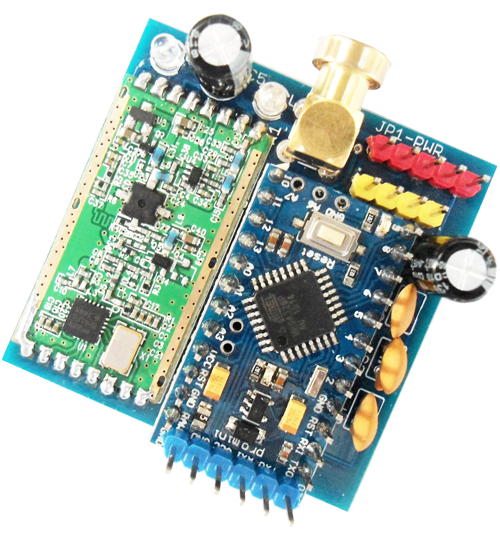
- This module doesn’t have a voltage regulator, check the Version 2 below which includes such a regulator
- Link to original post
- Link to PCB order page
- Link to the Wikipedia Wombat page
- Link to schematic and components list
- The resistors are soldered behind the arduino mini to gain space
Version 2
- This version is very similar and adds a voltage regulator
- Link to PCB order page
- Link to original post
The Sponge Board
User ‘ljakob’ from rcgroups did a PCB for Ultimate LRS Mini that can be ordered right now. It only uses through hole components and is very easy to build :
- Link to the the component list and schematic:
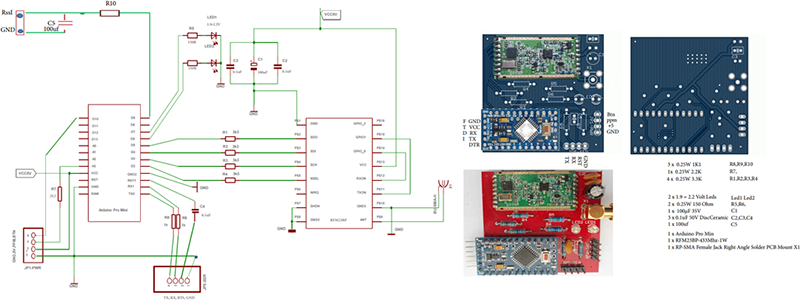
- Errata : the PPM is connected to the atmega A0 pin and not A3 as shown on this schematic. Notice that the firmware does support this board despite this difference from the reference schematic.
- Component list, or have a look at the ULRS Mini Bee Board component list
- RFM23BP 433MHz version link
- Arduino pro mini 5V 16MHz link
- R1 to R4 : 3.3k resistors, 1/4 watt
- R5, R6 : 220 ohms resistors, 1/4 watt
- R7 : 2.2k resistor, 1/4 watt
- R8, R9 : 1k resistor, 1/4 watt
- C1 : 150µF capacitor, 16V or more. Value is not critical, for example this 100 µF capacitor of this one will work. (not mandatory)
- C2 : 100pF capacitor (example) (not mandatory)
- C3 : 100nF capacitor (example) (not mandatory)
- C4 : 100nF capacitor (example)
- LED1, LED2 : standard LEDs, but not all brands and colors will give good results, these ones give a very good luminosity.
- SMA connector : this one or this one (angled at 90°)
- Pin headers : for example this one.
- RC transmitter connector : use this.
- Remark :
- No voltage regulator included, must be powered at 5V.
- Be careful to orient correctly the arduino pro mini and the RFM23BP, refer to the photo.
- Notice that it will even work without the capacitors C1 to C3 (C4 is still required), which makes it one of the simplest ULRS Mini to build.
- The LEDs can be any common model, but as their brightness can vary with their model and colour, ML37B gives good results. Orientation is important : the shortest pin must be closer to the PCB edge.
The LED closer to the PCB edge is ‘packet received’, the other LED is ‘packet sent’. - Its name Sponge Board comes from the legendary low IQ of Sponges, animals that don’t even have a brain… Just to say it’s very easy to DIY.
SMD ULRS Mini Modules
The Bee Board
- Interesting design from rcgroups user nopkorn
- Named after his passion for bees :
I like bees, It is a miracle. It has a small wing, smaller than itself. But it can fly.
- PCB file that can be uploaded to https://jlcpcb.com/
- The whole zip file has to be uploaded (more information about Gerber files on wikipedia)
- Notice that the Arduino pro mini has to be slightly cut with scissors or grinder :
- Component list and links
- Alternative component sources from rcgroups user gcp900 :
- Post 1, Post 2, Post 3
The Chamaleon Board V1.2
- Board proposed by rcgroups user spektr
- Variant of the Sami board
- Version 1.2 Eagle (SCH and PCB) files are here.
- The PCB (Gerber) files are here.
- The ZIP file above can simply be uploaded to https://dirtypcbs.com/store/pcbs
- Parts list is here.
The Butterfly Board
Warning : there are several user reports about issues with this board. To be on the safe side consider building another of the proposed boards.
Rcgroups user ‘Cereal_Killer’ made a PCB with SMD components, and much smaller than the Spongeboard.
- Link to the PCB order page
- Its name comes from its reduced size, and the components placed on both sides.
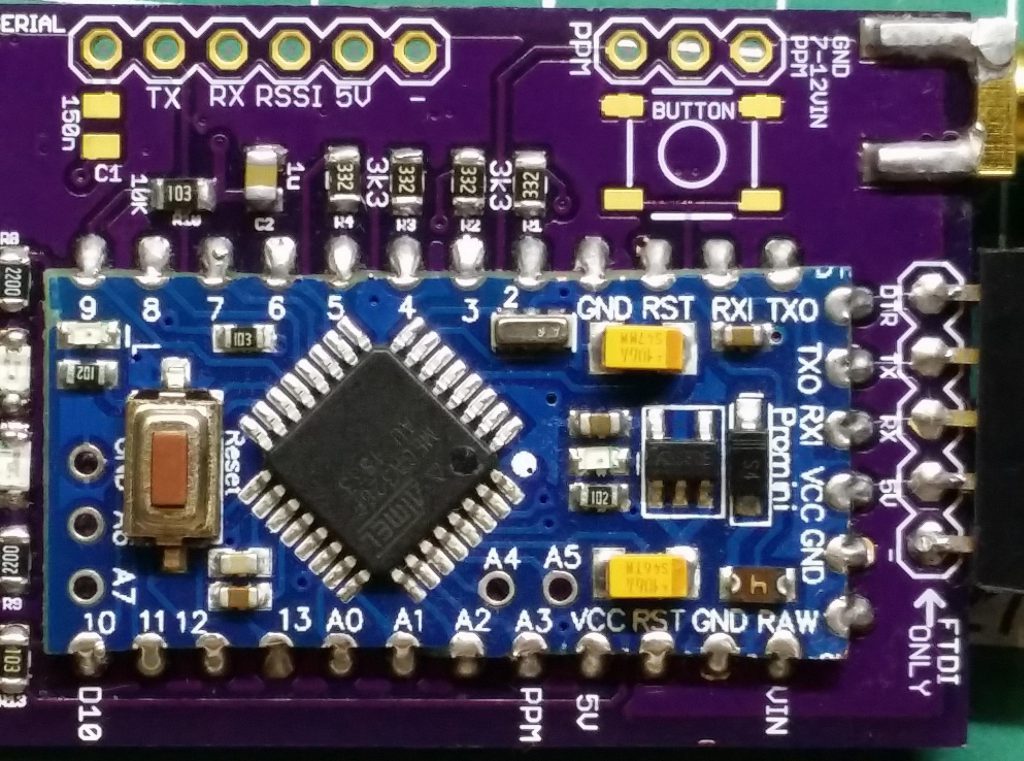
The Warthog Board
User ‘shaggibomb’ from rcgroups did a PCB for Ultimate LRS Mini which will fit in a JR case, has an RF filter and a switching power supply.
- Schematic of the main board:
- Schematic of the daughter board:
- Link to the schematic and PCB files.
- Prototype :
- Its name ‘Warthdog’ comes from the favourite animal of the user who designed this board, who lives in Namibia.
The Sami Board
Rcgroups user Samisin has made three SMD boards with a lot of features :
- Features
- Switching power supply
- USB
- Onboard bluetooth
- Hardware voltage shifter
- JR compatible format
- …
- Link to the order and download page
- Link to the schematics #1
- Link to the schematics #2
- Sami board (JR) component list
Work in progress
The Q-board
The Hummingbird Board
- rcgroups user mojtaba.hdpr is working on a new board here : link
Two ULRS Mini boards from China
The advantage of an open design like ULRS Mini si that users around the world are creating their own flavour. Recently I noticed a new ULRS Mini board on a Chinese discussion board.
Remark : the user who did this contacted me by email to say he was sorry to have used the ULRS Mini design and logo without authorization. Just to make it clear, there’s no problem here and I allow anyone to build hardware based on ULRS Mini reference schematic and have the ULRS logo / name on it.
- Video 1, video 2, video 3
And another user from China sent me some photos of another design of ULRS Mini :
Sami Board variant
- Made by rcgroups user ujjwaana
- Original link in ULRS thread
- To be named
Where to find components ?
- Rcgroups user FlyingW has created a list of links to buy ULRS Mini components here.
- Arduino mini can be found here at $2.49
- Digikey or Farnell should also have all the components needed.
- For the TX, the connector that will receive the RC TX pins is this one:
- Some ULRS Mini boards may require a slightly different component list, but here are the most common ones :
- Alternative component sources from rcgroups user gcp900 :
Pinouts and datasheets
- RFM32BP : datasheet, pinout, registers
- Arduino pro mini : documentation, pinout
- STM32F103 Blue Pill board : documentation, pinout, schematic
And…
Let me know about your progress building this DIY Ultimate LRS Mini, I’ll publish your PCB or pictures on this page. Feel free to ask your questions or post your Ultimate LRS Mini on the Ultimate LRS rcgroups thread. ‘Windspeaker’ user from rcgroups forums has made a complete write-up of his experience in building the Ultimate LRS mini, check it out here.
Programming an Arduino pro mini with an USBasp programmer
The Arduino pro mini boards don’t provide the JTAG connector that’s used to program with an USBasp programmer. In case you need one (for example if you want to reflash the bootloader, here’s the pinout :
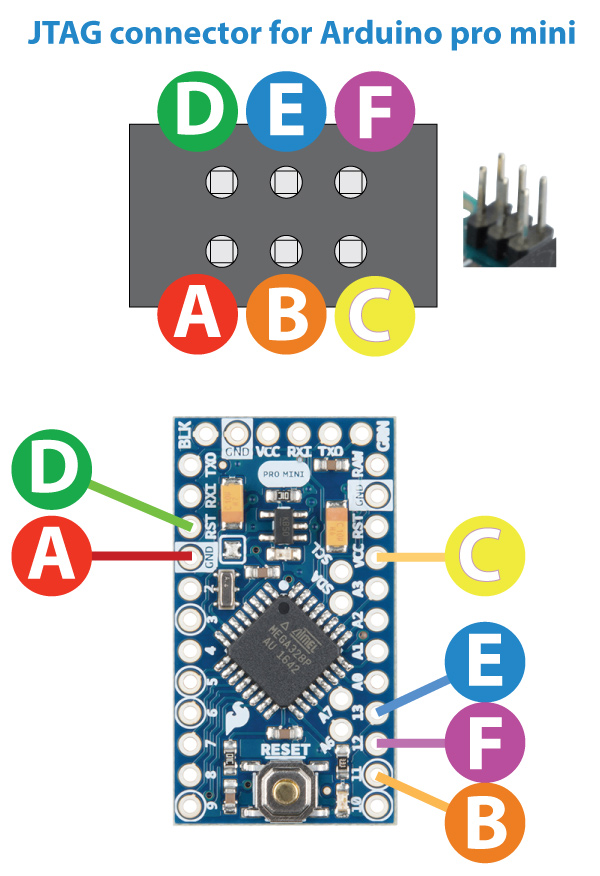

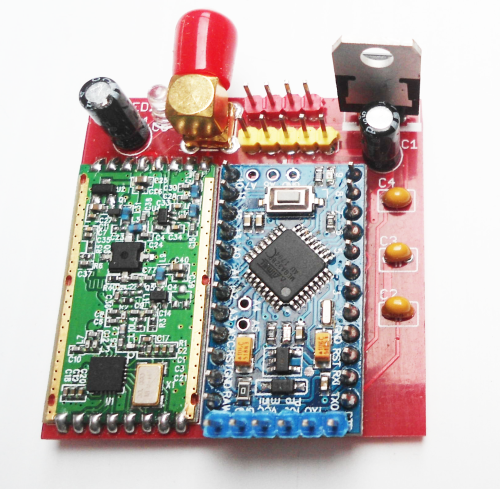
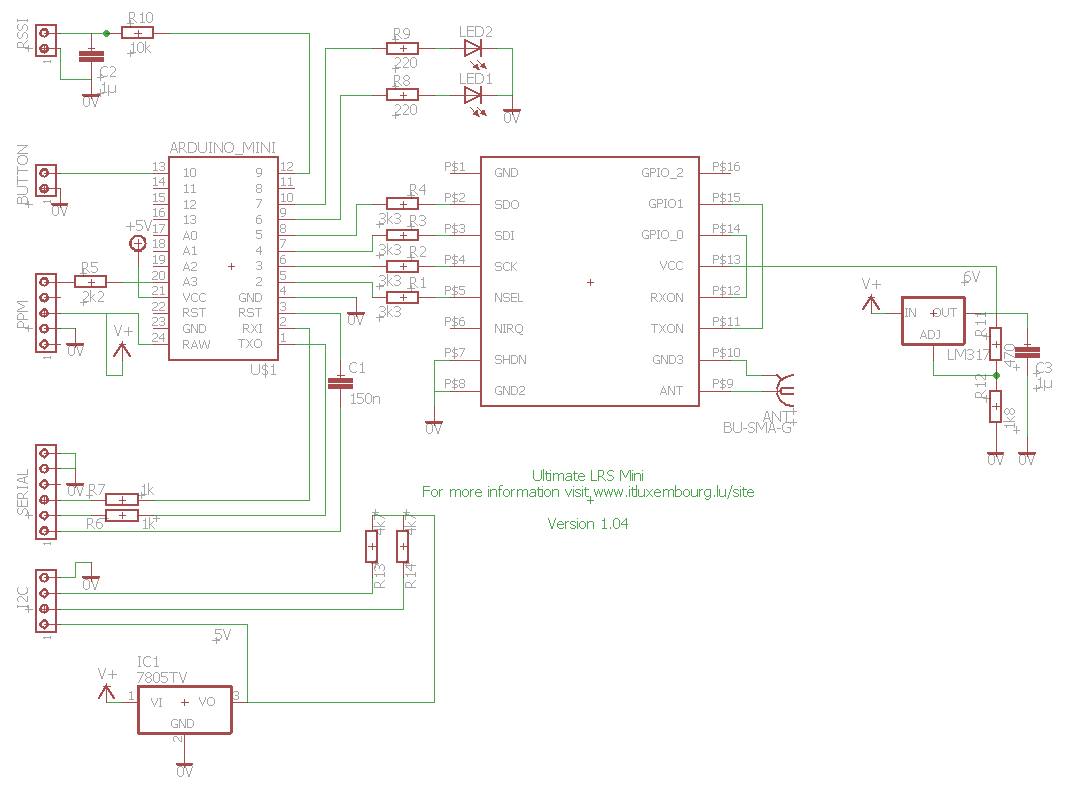
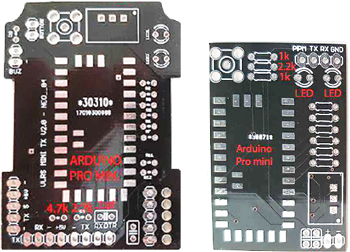
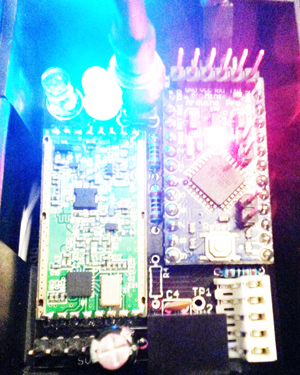
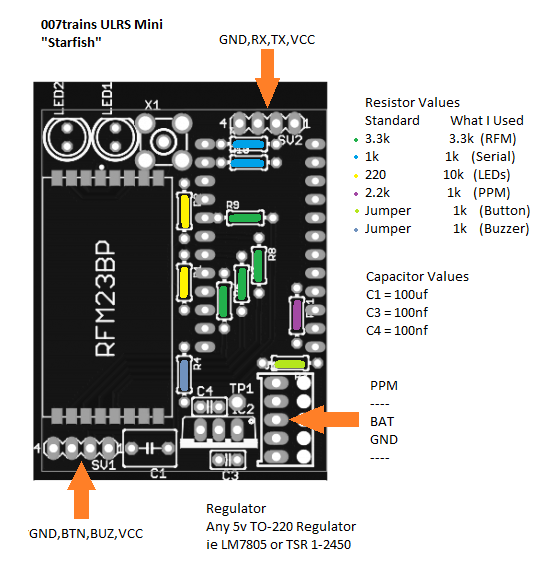

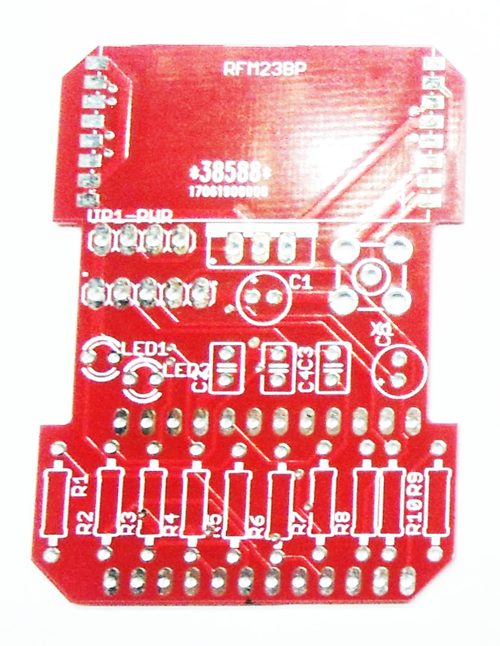
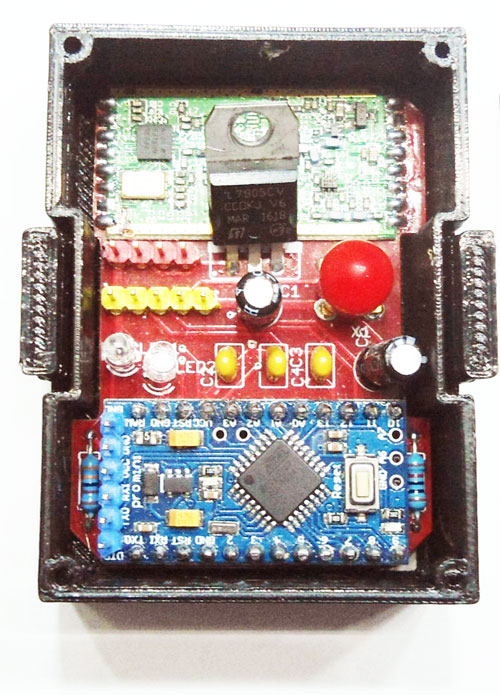

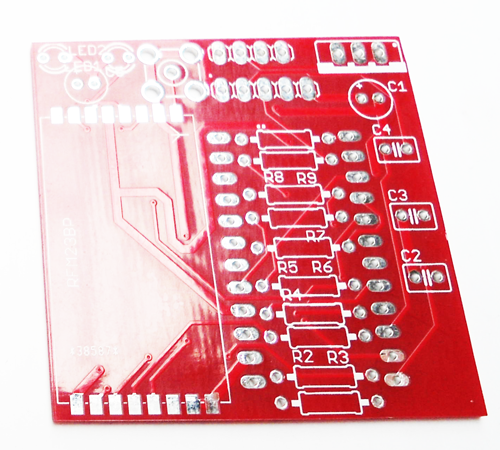
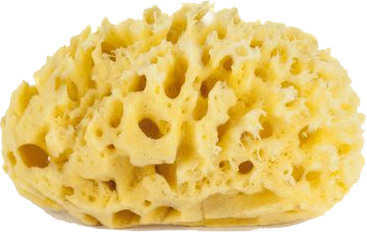
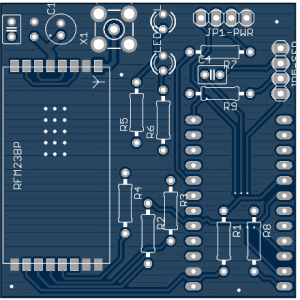
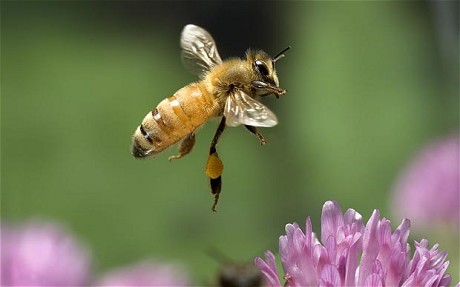
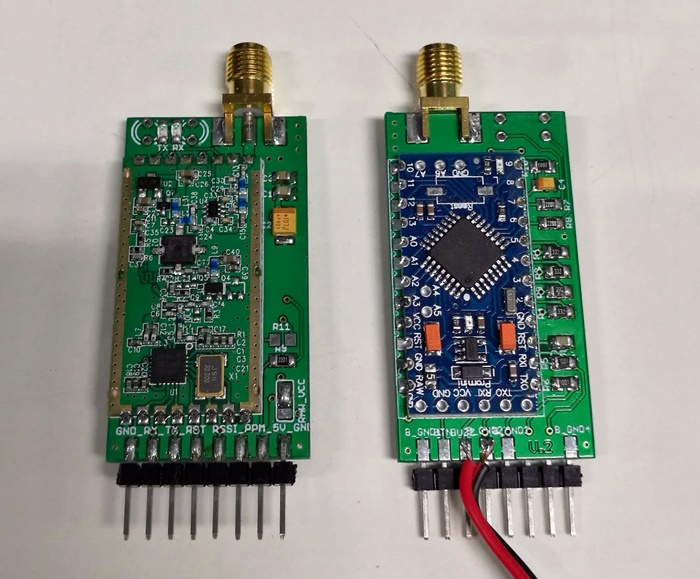
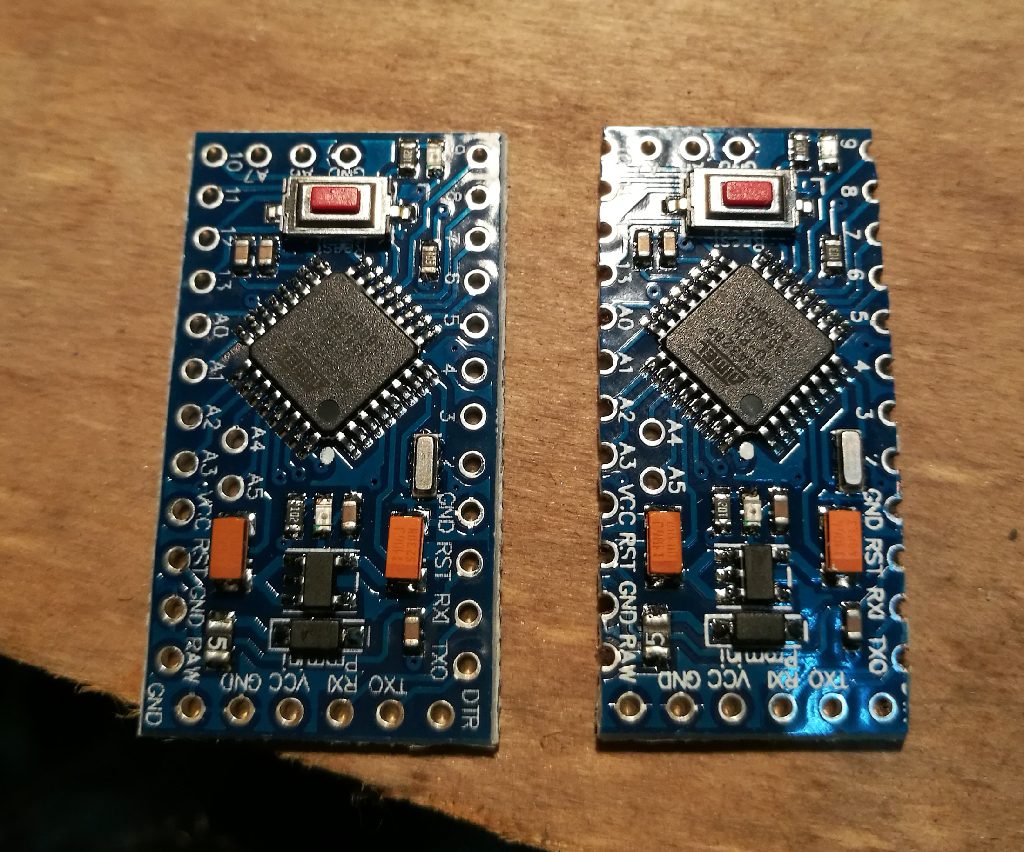

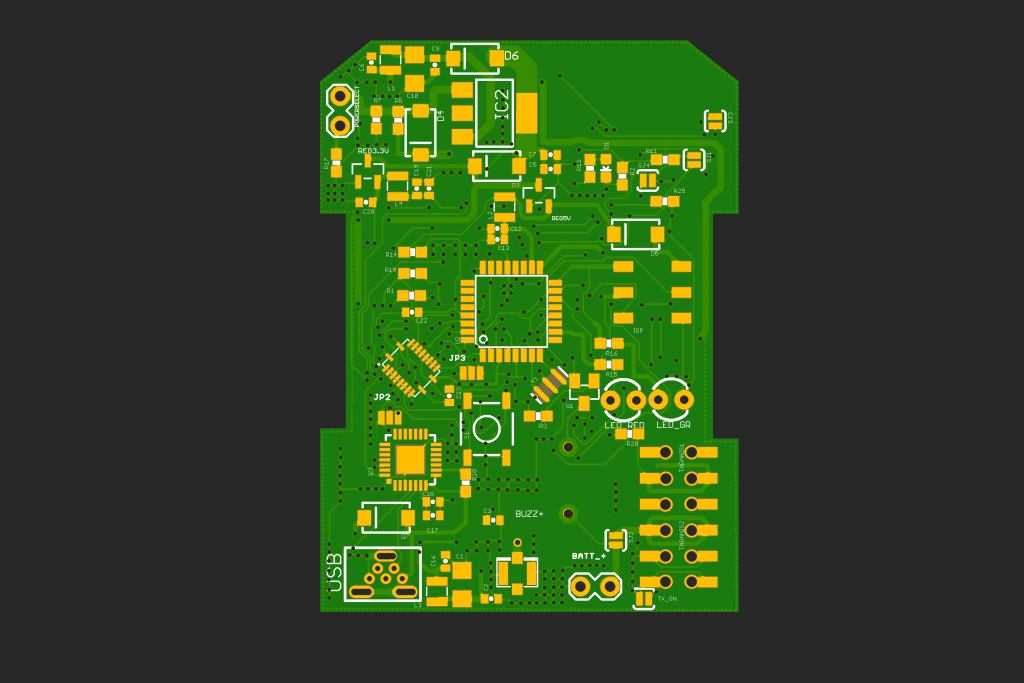


![a9301457-117-ULRS_TX[1]](http://www.itluxembourg.lu/site/wp-content/uploads/2016/03/a9301457-117-ULRS_TX1-1024x690.jpg)
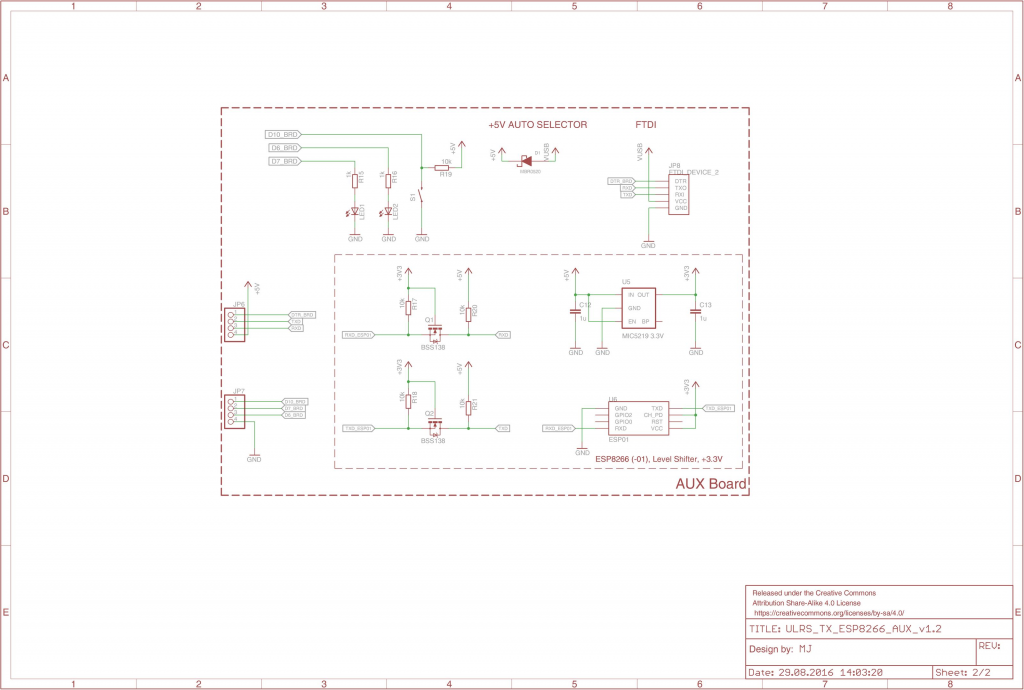
![a9301456-86-IMG_20160831_133057[1]](http://www.itluxembourg.lu/site/wp-content/uploads/2016/03/a9301456-86-IMG_20160831_1330571-1024x735.jpg)

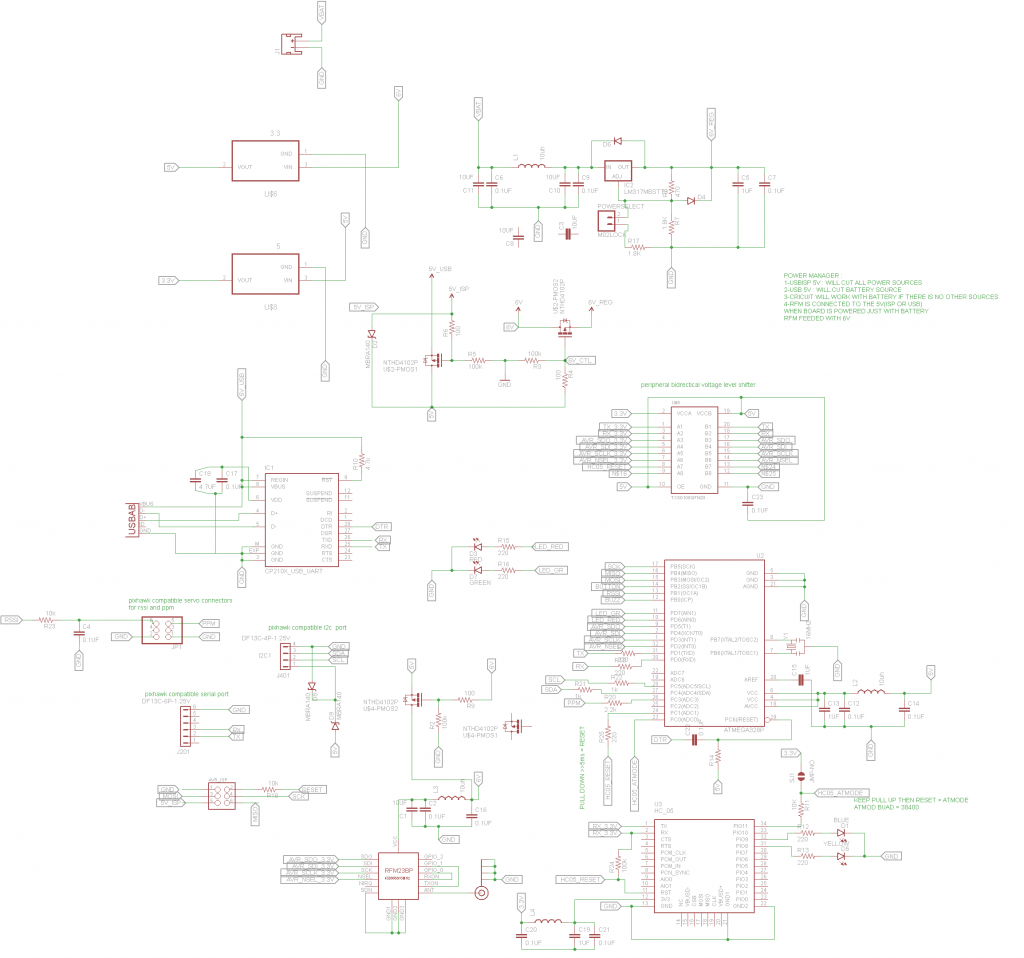
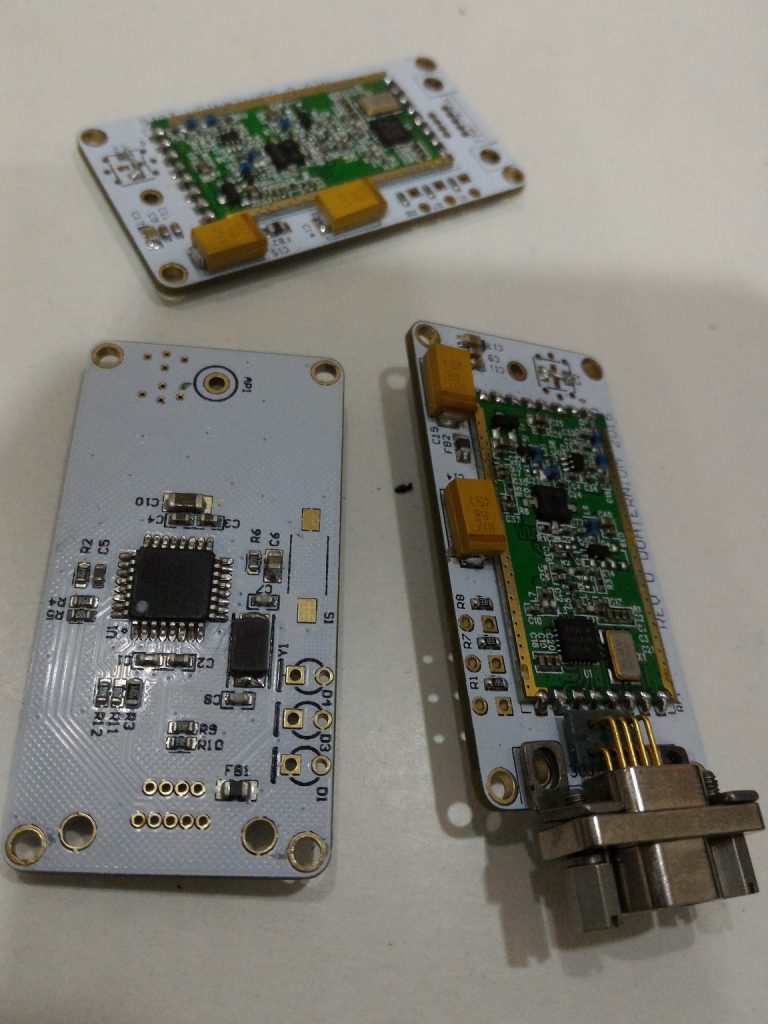
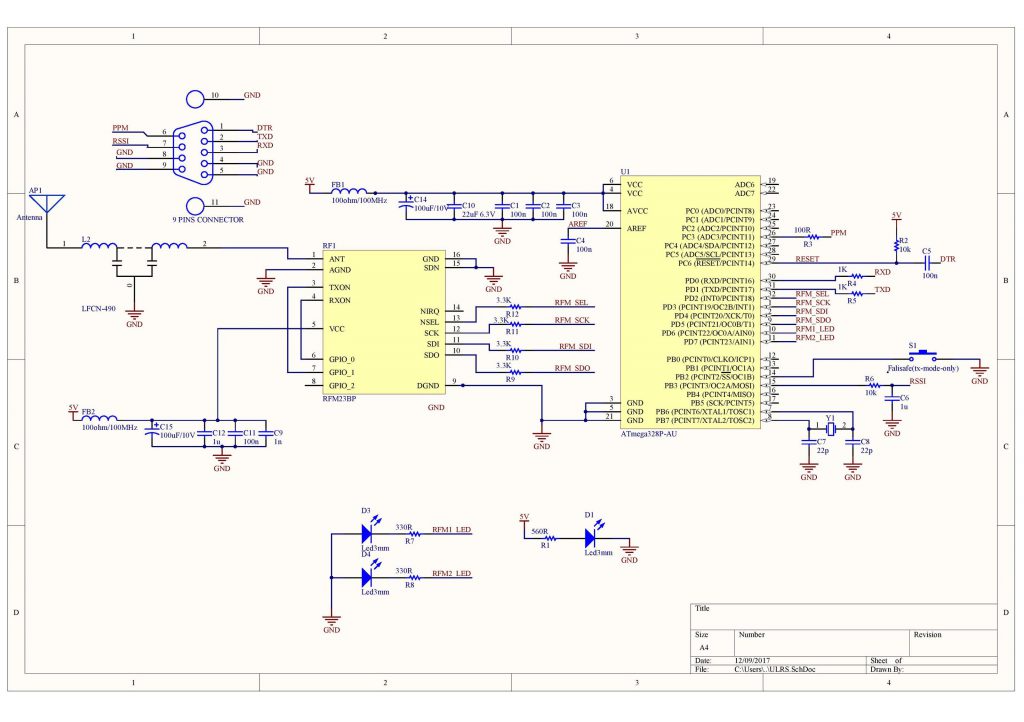
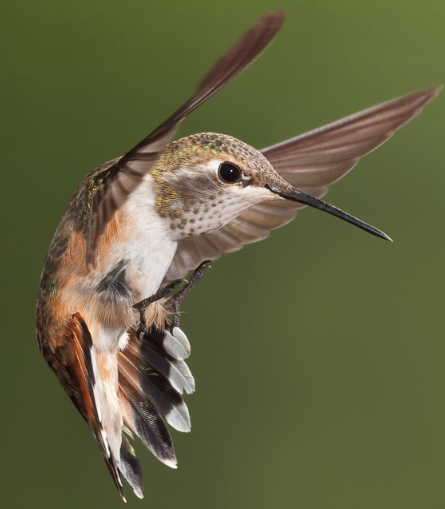
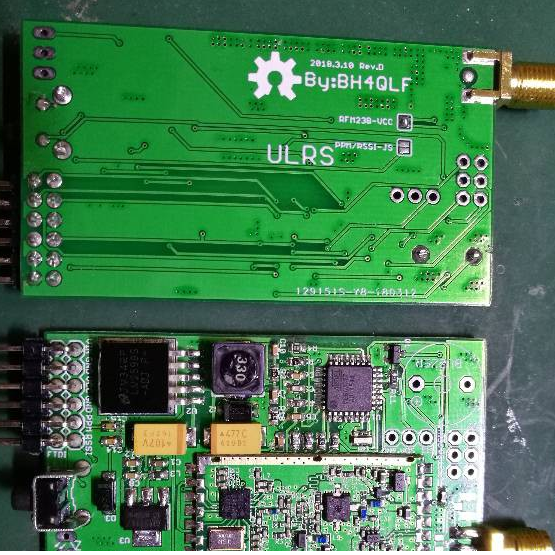
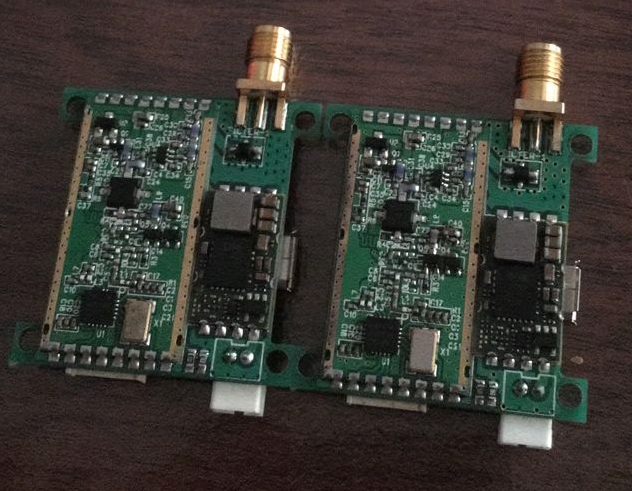
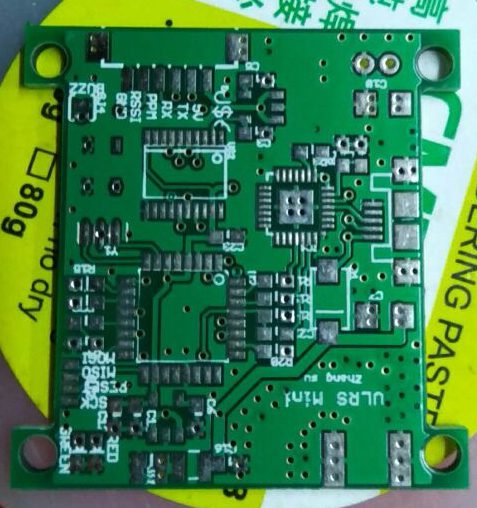
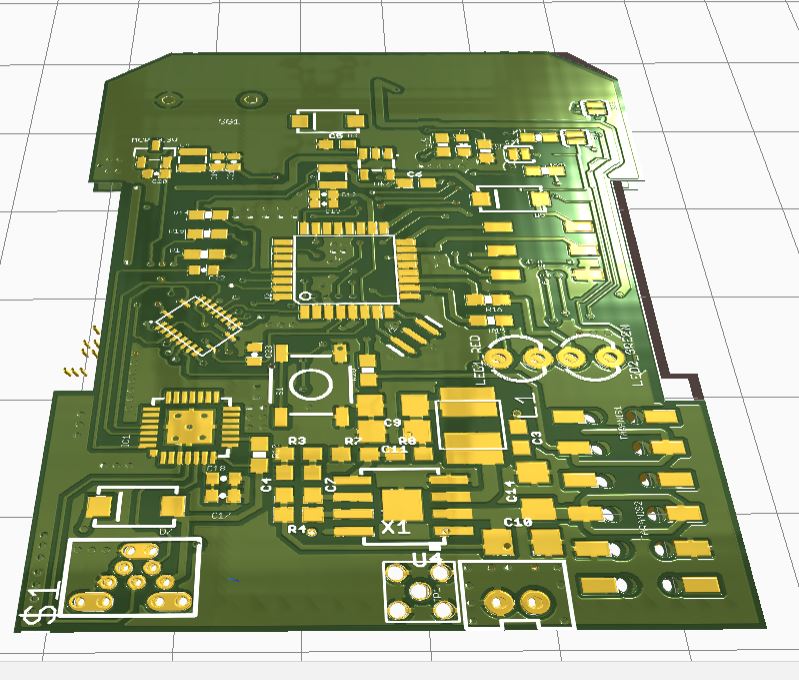
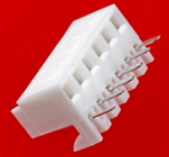
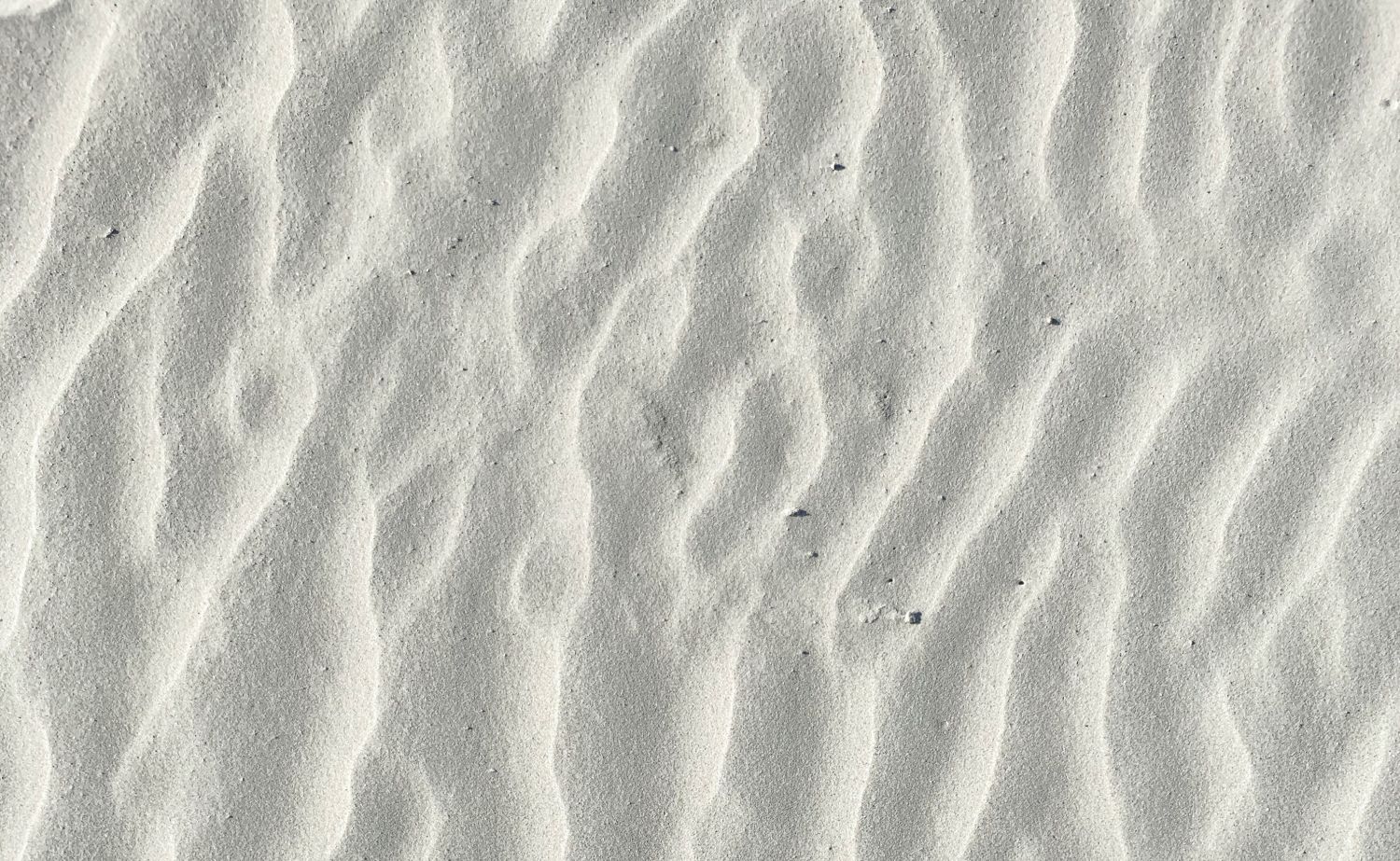
Hi,
I was trying to use RFM23BP with ESP32 microcontroller. I was surfing through the webpages for it and i found two kind of schematics. the one you guys are using TXON–>GPIO1 and RXON–>GPIO0. and vice versa. Can you state why have you connect RX and TX for your board?
Hi, please contact me on the rcgroups forum here : https://www.rcgroups.com/forums/showthread.php?2037442-Ultimate-LRS-Hassle-Free-Full-Mavlink-16-Channels-Fly-More/page1098
Unfortunately the firmware is specific for the RFM23BP modules. Notice that ULRS offers a range of at least 40 km.
hello, i would like to know if ULRS work on submicrolrs board please?
thanks
sam
Sorry, please check the list of supported hardware here : http://www.itluxembourg.lu/site/material/#Radio_Modules
Guten Tag
I have built two wombat LRS modules using the dirtyPCB boards and have loaded firmware to them using the ULRS updater.The Ultimate LRS control center does not seem to run on either of my Win10 machines…Loads the main window but pull down boxes or controls are not active and app freezes.
Cmd window debugger also does not seem to work.
With no bind button in the ULRS circuit how do you bind these modules in a stand alone environment ??? Using Putty I see that the receiver boots up in bind mode. Not sure of the transmitter boot state?
Just an observation … the digital arduino pins used to control the radio module are different then those used in the OpenLRS design.
I’m assuming the OrangeMicro Tx uses the same arduino control pins as the wombat ULRS. If that were true it seems that the Chrome OpenLRSng Configurator should work with ULRS modules provided you use the OrangeMicro tx and OrangeMicro Tx as Rx firmware options. I tried this but modules would not bind?
Is there an easy way to put the transmitter module in stand alone lopback mode just to test the rfm23BP module???
Thanks for any comments you can make .
Please post to rcgroups forum here : https://www.rcgroups.com/forums/showthread.php?2037442-Ultimate-LRS-40-km-APM-Telemetry-RC-link-for-54-(using-2-OrangeRX-1W-TX)/page872 but try to disable bluetooth on your computer, that’s the usual cause of lockup.
Hi
firstly, love your work.
Do you think it be prudent or paranoia to add a second RFM23BP, both connected to the mini which then carries out a diversity function?
I am thinking of the new pixhawk2 cube module that plugs into a board populated with a mini, the RFM23BP (or 2), PSU, and of course some I/O connections (PWMs, SPI, UART). This would reduce external wiring and, I believe, would be a great flight controller/receiver/telemetry unit.
I am keen to pursue this idea and would be very interested in your thoughts.
It’s an excellent idea, given the price of RFM2BP modules it’s cheap to add diversity.
Hi Benoit
Thanks for the encouragement, I only move ahead because I stand on the shoulders of others.
Just a few questions if you can find the time.
1. Does the Mini need to be a 3.3V Version?
As the RFM23BP specifies 3.3V logic I/O. 5V minis I have used output 5V on the I/O.
2. Apart from possible restrictions from the question above and assuming same ATMEGA328 pin connections, could I use a Nano in place of the Mini?
The convenience of in built FTDI for the Tx (Ground) unit is my thinking.
3. If I were to mount 2 RFM23BPs back to back on a double sided PCB, do you think this would present interference problems. I intend to run the supply to the Rf Mosfets at 9V.
4. When I do receive the RFM23BPs and build the “Twin transceiver mini ULRS” could you help me with the diversity software?
Regards
Jon
Many interesting questions, please post them in the forum here because most users are already there and could be interested by the answers too : https://www.rcgroups.com/forums/showthread.php?t=2037442
Is it possible to use Si4432 instead of RFM23b module?any schematic or pin assignments that need to be consider?
Thanks
It’s made for the RFM23BP module, that includes a Si4432, so the firmware should work with a Si4432 but I can’t provide specific support for it. But let me know if it works ?
Is the wiring for RFM23B the same as wiring for RFM22?thanks
Exactly the same as the RFM22B. Beware that some pins have different naming (TX_ANT etc), but they must be connected exactly the same.
Hi,
I’ve made my module according to “ULRS Mini Reference Schematic V1.04” but with Si4432 instead RFM23BP. My roblem is that power measured with a RF meter is 2mW. Can You help me, please? I don’t know where is the problem. Si4432 don’t have TX_ant, RX_ant pins.
On Si4432 modules found on ebay, usually the GPIO pins are already connected to the TX_Ant / RX_Ant pins (through PCB traces), but I guess it’s connected in the opposite direction that is used by ULRS. This would explain the very low output power. Maybe it’s possible to cut and reconnect the traces on your module PCB, else I’d suggest to use an RFM22B or RFM23BP module.
[…] ULRS – darant plokštes oshpark, galima sutilpt su trimis moduliais į < 50$, o atstumo ir galimybių tikrai užteks metams-kitiems. […]
have trusted seller modules were $ 16 for 2 pcs.
Thanks for the info !
Would the ulrs mini be compatible with openlrsng, if so what board type would i select?
Hi Kirk, the ULRS mini is not compatible with openlrsng. The pins connected have been chosen to make the easiest possible connection between the RFM module and the Arduino mini.
Ok, thankyou for the reply. I still have a lot to learn about arduino. So as far as board config is concerned would the difference between brands using atmega328 and RFM23BP is the comunication pins used?
Mainly yes. But some pins have different hardware features. For example the hardware SPI is only available on specific pins.
One benefit that the Orangerx boxes have is the “module” fit into a controller case, like the 9xr or Taranis…
Would it be possible to install a bluetooth into the case of the controller and have the ground side unit connected to a laptop via FTDI cable?
The blue tooth is just a passthrough correct?
Yes bluetooth will work and you’ll find all instructions to connect it here : http://www.itluxembourg.lu/site/using-ultimate-lrs-with-a-bluetooth-module/
[…] just tested my Ultimate LRS Mini board with a quick arduino sketch, it runs […]
Hi,
I’ve just finished soldering my first module (see image-link). PCBs were made at http://dirtypcbs.com/ for 14 USD including shipping and since anything is through the hole is’s simple enough to solder.
But I have a problem: The arduino is working fine, blinking on port 6 and 7 works. But ULRS is not responding in the new beta console. Parameter saving seems to have no effect. I don’t get an Spectrum analyzer or anything useful in the UI.
Am I doing something wrong or do I have to supply a PPM signal?
Thanks
Leif
This board will only be supported with the 2.24 beta version, that should come very soon now. (No PPM signal is required)